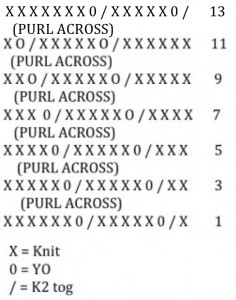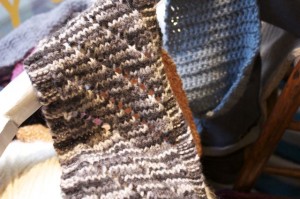Today’s scarf gets a little lacy! Only 2 more scarf patterns left!
Over the last two weeks, we’ve shared with you some of the scarves we’ve been making for our Hat & Scarf Charity Drive at the Lion Brand Yarn Studio. Today, we continue with 8 days of scarves. Whether you’re making them as gifts or for charity, come back from now until Thanksgiving for inspiration & patterns for easy scarves from the Studio’s staff.
Gillian’s Diagonal Scarf (shown in Vanna’s Choice Charcoal Print)
CO 24.
Row 1 – 8: Knit.
Begin Row 1 of chart
Row 1 of chart: K4, follow chart , k4. (Garter border)
Repeat chart rows for entire body length, keeping garter stitch border
Row 2 and every WS row: K 4, purl across chart, K4
Row 3 – 11: follow chart, maintaining garter stitch border
Repeat chart until desired length
End with 8 rows of Knit
Bind off and weave in ends.
*As with all of our scarf patterns shown, we only used one ball for our scarves, but you can use two and make them as long or short as you wish. Vanna’s Choice’s recommended hook size is J-10; its recommended needle size is US9.


You must be <a href="https://blog.lionbrand.com/wp-login.php?redirect_to=https%3A%2F%2Fblog.lionbrand.com%2Fexperiment-with-diagonal-lace%2F">logged in</a> to post a comment.
Joann
I do a similar pattern with crochet — it works up very nicely — I’ve made a few Project Linus baby blankets with a stitch similar to this — I work either 7, 8 or 9 double crochets, and then skip one and work it until I have a blanket.
Rosie
It appears from the photo that the middle section between the garter stitch borders is stockinette stitch (knitting on the odd rows and purling on the even ones). However, your chart has knitting on each row, No purling. Am I confusing the stitch pattern?
Patty says: The chart rows were meant to be the RS only with the WS being purled back (creating stockinette). We have amended the chart to clarify. Hope that makes it easier to follow. Enjoy!
Clarisse
Hi: Just checking:row one is the bottom line of the chart? The “1”, “3” etc. refer to the rows, right? I want to be sure that I understand that I start at the bottom of the chart and work up as directed. I am new at this chart thing!
Thanks!!
Patty says: Yes, the numbers refer to the rows. Charts are always read from the bottom up. Charts represent the public side of the work. Traditionally, the RS rows are read from right to left (the same way you work on your needle) and the WS rows are read from left to right. In this case, just to simplify, the chart only shows the RS rows, since all WS rows are simply purls. Welcome to chart reading. I hope your scarf turns out great!
Sandra
In the picture of this scarf the diagonal appears to run straigh from one garter stitch border to the opposite side. I’ve completed one pattern and have been knitting in reverse ever since. It seems when I go back to row one of the chart the diagonal moves over 1 stitch to the left and does not look right. Has anyone else experienced this?
Or is susppose to take a little zig zag. I can’t tell from the picture.
Patty says: I don’t remember if it had a bit of a zig zag. However, if you don’t want it to, simply use the line 13 I added. Remember to “read your knitting” and respond visually to what you want to make. The K2tog & YO simply moves over one spot each row. The K2tog is always over the YO from the previous knit row, followed by a YO
Cyndy
I made this scarf and yes it does move over one stitch to the left. I found this very easy to do and easy to remember the pattern. I liked it over all, I made mine out of a purple worsted weight that I found in my stash and used almost a complete 100 G/200 yard ball. I wanted to end on a complete pattern. the only thing I don’t like is the K4 at each side as it makes the sides curl in where the K4 ends. Maybe a K1P1 ribbing to make it lay flat? I’m not sure and will have to try it again with a different edging.
Janice Kessler
I’m having the same problems, so I tried adding a row 13 to the motif…then I realized that it seems we have two extra stitches or something in the motif and the pattern would lean to one side. I’m just learning and this problem has been very frustrating for me. I thought it was me.
Patty says: Adding a row 13 would not result in 2 extra stitches. If you don’t want the jog in the scarf, use the line 13 I added. Remember to “read your knitting” and respond visually to what you want to make. The K2tog & YO simply moves over one spot each row. The K2tog is always over the YO from the previous knit row, followed by a YO
Joan Bundt
Just to clarify as i love the looks of this scarf–Do I read the pattern right to left or left to right. I’ve never read a chart before.
Thanks for the pattern.
Joan
Patty says: Since many readers ask the same questions, it’s helpful to read through the other comments to see if your question has already been answered.
As answered in an early comment:
Patty says: Yes, the numbers refer to the rows. Charts are always read from the bottom up. Charts represent the public side of the work. Traditionally, the RS rows are read from right to left (the same way you work on your needle) and the WS rows are read from left to right. In this case, just to simplify, the chart only shows the RS rows, since all WS rows are simply purls. Welcome to chart reading. I hope your scarf turns out great!